| Logan Formation | |
|---|---|
| Stratigraphic range: | |
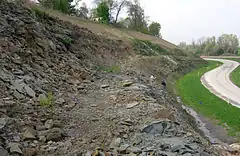 Logan Formation exposed in Wooster, Ohio. | |
| Type | Sedimentary |
| Unit of | Waverly Group |
| Sub-units | Berne, Byer, Allenville, Vinton |
| Underlies | Maxville Limestone, Pottsville Group, and Rushville Shale |
| Overlies | Cuyahoga Formation; Black Hand Sandstone |
| Thickness | 0 to 40 m |
| Lithology | |
| Primary | sandstone, siltstone, conglomerate |
| Other | shale |
| Location | |
| Region | Appalachian Basin |
| Country | United States |
| Extent | Ohio, West Virginia |
| Type section | |
| Named for | Logan, Ohio |
| Named by | Andrews, 1870 |
The Logan Formation is the name given to a Lower Carboniferous (early Osagean) siltstone, sandstone and conglomeratic unit exposed in east-central Ohio and parts of western West Virginia, USA.
Stratigraphy and paleoenvironment
The Logan Formation was named by Andrews (1870) and originally described as a "buff-colored, fine-grained sandstone" above the Waverly Formation and below the Maxville Limestone. Bork and Malcuit (1979) concluded that the Logan Formation was deposited on a shallow marine shelf in a generally transgressing sea. The age of the Logan Formation has been established as early Osagean (Tn3) by the occurrences of brachiopods, ammonoids, conodonts and miospores (Clayton et al., 1998; Matchen and Kammer, 2006).
References
- Andrews, E.B. (1870). "Report of progress in the second district, Part II, IN Report of progress in 1869". Ohio Division of Geological Survey Report of Progress. 2nd Series: 1091–1094.
- Bork, K.B.; Malcuit, R.J. (1979). "Paleoenvironments of the Cuyahoga and Logan Formations (Mississippian) of central Ohio". Geological Society of America Bulletin. 90: 89–113. doi:10.1130/0016-7606(1979)90<1091:potcal>2.0.co;2.
- Clayton, G.; Manger, W.L.; Owens, B. (1998). "Mississippian (Lower Carboniferous) miospores from the Cuyahoga and Logan Formations of northeastern Ohio, USA". Journal of Micropalaeontology. 17: 183–191. doi:10.1144/jm.17.2.183.
- Matchen, D.L.; Kammer, T.W. (2006). "Incised valley fill interpretation for Mississippian Black Hand Sandstone, Appalachian Basin, USA: Implications for glacial eustacy at Kinderhookian-Osagean (Tn2-Tn3) boundary". Sedimentary Geology. 191: 89–113. Bibcode:2006SedG..191...89M. doi:10.1016/j.sedgeo.2006.02.002.
 Conglomerate in the Logan Formation exposed in Wooster, Ohio, USA.
Conglomerate in the Logan Formation exposed in Wooster, Ohio, USA. Brachiopod internal and external molds in the Logan Formation in Wooster, Ohio.
Brachiopod internal and external molds in the Logan Formation in Wooster, Ohio. The bivalve Aviculopecten subcardiformis from the Logan Formation in Wooster, Ohio (external mold).
The bivalve Aviculopecten subcardiformis from the Logan Formation in Wooster, Ohio (external mold).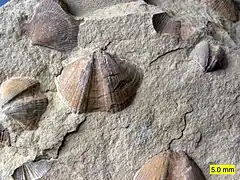 Bivalves (Aviculopecten) and brachiopods (Syringothyris) in the Logan Formation in Wooster, Ohio.
Bivalves (Aviculopecten) and brachiopods (Syringothyris) in the Logan Formation in Wooster, Ohio.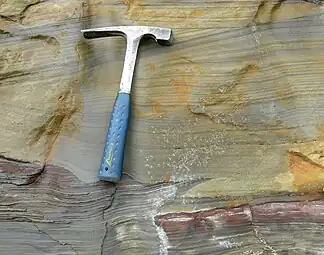 Cross-bedding and scour in the Logan Formation of Jackson County, Ohio.
Cross-bedding and scour in the Logan Formation of Jackson County, Ohio. Schizodus medinaensis; a bivalve from the Logan Formation in Wooster, Ohio (internal mold).
Schizodus medinaensis; a bivalve from the Logan Formation in Wooster, Ohio (internal mold).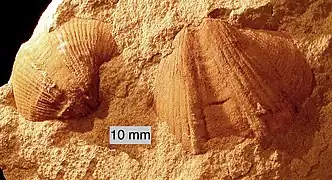 Syringothyris sp.; a spiriferinid brachiopod from the Logan Formation in Wooster, Ohio (internal mold).
Syringothyris sp.; a spiriferinid brachiopod from the Logan Formation in Wooster, Ohio (internal mold). Syringothyris external mold with borings; Logan Formation; Wooster, Ohio.
Syringothyris external mold with borings; Logan Formation; Wooster, Ohio. Syringothyris texta (Hall 1857), dorsal view, internal mold. Lower Carboniferous of Wooster, Ohio.
Syringothyris texta (Hall 1857), dorsal view, internal mold. Lower Carboniferous of Wooster, Ohio.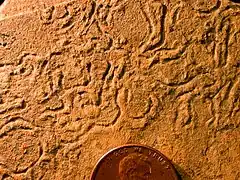 Helminthopsis ichnosp.; a trace fossil from the Logan Formation in Wooster, Ohio.
Helminthopsis ichnosp.; a trace fossil from the Logan Formation in Wooster, Ohio.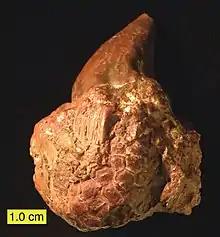 Crinoid calyx from the Logan Formation in Wooster, Ohio, with a conical platyceratid gastropod (Palaeocapulus acutirostre) attached.
Crinoid calyx from the Logan Formation in Wooster, Ohio, with a conical platyceratid gastropod (Palaeocapulus acutirostre) attached.
This article is issued from Wikipedia. The text is licensed under Creative Commons - Attribution - Sharealike. Additional terms may apply for the media files.